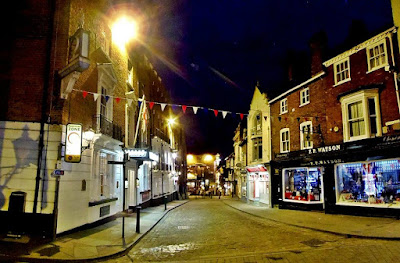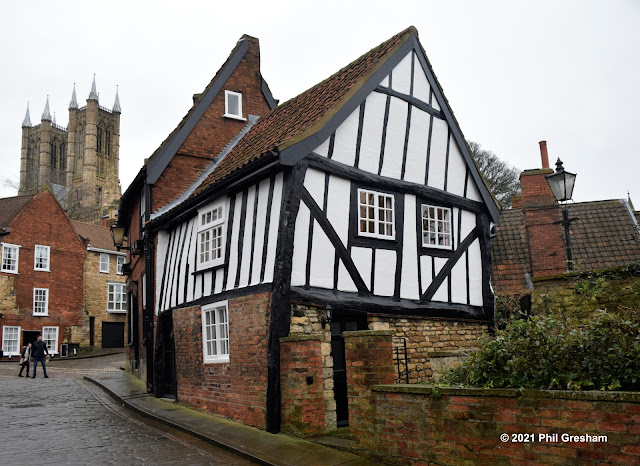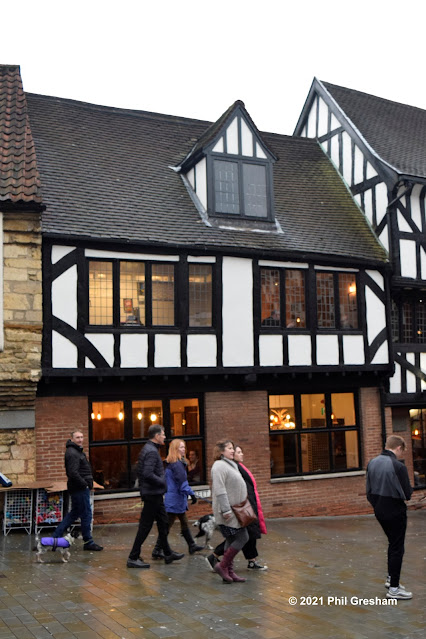When William the Conqueror ordered the building of Lincoln Castle 166 houses, and a church, were demolished. The people who lived in these houses were moved to an area north of the Roman north gate: this area was named New Port.
 |
| Newport Arch with the Cathedral and Bail beyond |
A broad road ran north from Newport Arch to the edge of the Newport suburb: this had been the northern approach, Ermine Street, to the City since Roman times. There was a large market held along this road and it is thought that the first St Nicholas Church was built about this time (mid 12th century) on the northeast corner of Church Lane, then known as Sastan's Gate. Along with St Peter in Eastgate, St Nicholas' was destroyed in 1643, during the Civil War. It was used as a battery for an assault on the castle and the lead of the roof was melted to make shot. The remains of the church were still visible into the early 19th century, but by the middle of the century maps of the area only marked St Nicholas' graveyard. According to Venables, the wall of the graveyard was constructed from the remains of the church in 1757. St Nicholas is the patron saint of merchants, travcllers, children, and thieves and was very popular in the middle ages: merchants travelling between communities would visit his churches to pray for a safe journey.
 |
| Possible site of St John Baptist Church, north of Broadway |
Close to the site of the present-day Bishop Grosseteste University once stood St John the Baptist church. This church was built about the same time as St Nicholas', on Chapel Lane, and probably stood in the middle of the road surrounded by the extensive Newport market, it was demolished in 1545, at the time Lincoln 'lost' 36 other churches.
 |
| St Hugh's 23 Newport |
During the 13th century, a number of priories were established in Lincoln. The Augustinian friars arrived in Lincoln in 1269 and their priory was built on the corner of Newport and Rasen Lane. The priory would have been set back from the road: it probably stood where number St Hugh's, 23 Newport now stands, the former boys' home. The priory had in the region of 30 friars and was surrendered to the bishop of Dover in 1538-9.
Newport was a poor community, having no place of worship, the parishioners had to rely on local clergy to provide communion and other services, the benefice of St Nicholas was preserved by the preaching of an annual sermon in the churchyard and parish business was conducted at "The Turk's Head", a local public house on the corner of Newport and Cecil Street.
The population of Newport more than tripled between 1801 and 1831 bringing many social problems. In 1822 Edward James Willson, a local architect had written to Subdean Bayley: "Newport it seems to me is in more need of civilisation than any other part of the City. There is no church, no person of the least influence, no checking of the grossest rudeness and insubordination".
The Lincolnshire Advertiser wrote in 1835 "We are led to these remarks from the great increase of the City of Lincoln without Newport Gate, forming as it does a town to itself while there is not a church within a considerable distance to which the population may repair on the Sabbath. The natural consequence of this is that the inhabitants generally are either complete heathens or violent sectarian bigots. We do most sincerely trust that some steps will be taken to remedy this crying evil".
 |
| St Nicholas' church |
In 1838 it was decided a new church would be erected on a site approximately halfway between the sites of the 'lost' churches of St John and St Nicholas. The architect was George (later Sir George) Gilbert Scott. He won a competition to design the new St. Nicholas. The foundation stone was laid in April 1839, and the building was consecrated on the 24thNovember, 1840 by Bishop John Kay.
Behind St Nicholas' church is Newport Cemetery, the original one-acre plot was consecrated 31st December 1855, expanded in 1869 and c 1900. 139 World War I servicemen who were treated at the 4th Northern General Hospital at The Lincoln School (now Lincoln Christ's Hospital School) who did not recover from their injuries were buried in the Commonwealth Graves Commission section at Newport Cemetery. A further 120 World War II servicemen were buried in the CWGC section
Roman remains have found during grave-digging: an inscribed Roman tombstone, Roman cremation urns, amphora handle, samian base, lead figurine.
During the Roman occupation, cemeteries were laid out along main roads outside of towns. The Roman cemetery at Newport stretched from Rasen Lane to Broadway on both sides of the road
A short distance from St Nicholas' church is Willsons Cottages. This medieval-looking building was built in the early 18th century out of reclaimed church materials. It was altered by Edward James Willson, a local architect, in 1834.
 |
| Willson's Cottages |
On the corner of St John's Road, there is the former St Nicholas' Vicarage. This building was designed by local architect William Watkins in 1879 for the Rev. F W Blenkin, in Queen Anne Revival style. Retaining many of its original features inside and out, it is now apartments.

St John's House
Lincoln Diocesan Training College was founded in 1862 as a training college for schoolmistresses, it became Bishop Grosseteste College in 1962, becoming Bishop Grosseteste University in 2007
The Radion Cinema opened in July 1939 and closed in July 1960, now Radio Lincolnshire studios, read more about this cinema, and other lost Lincoln cinemas, by clicking here. The building is on the site of Staunton House built for Isabella Staunton, the widow of Rev William Job Charlton Staunton (1802-1840) of Staunton in Nottinghamshire. The house was demolished in 1938 for the building of the Radion cinema.
|
































